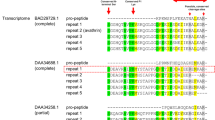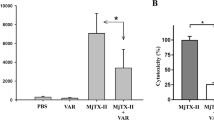Abstract
Madanin-1 and chimadanin are two small cysteine-free thrombin inhibitors that facilitate blood feeding in the tick Haemaphysalis longicornis. Here, we report a post-translational modification—tyrosine sulfation—of these two proteins that is critical for potent anti-thrombotic and anticoagulant activity. Inhibitors produced in baculovirus-infected insect cells displayed heterogeneous sulfation of two tyrosine residues within each of the proteins. One-pot ligation–desulfurization chemistry enabled access to homogeneous samples of all possible sulfated variants of the proteins. Tyrosine sulfation of madanin-1 and chimadanin proved crucial for thrombin inhibitory activity, with the doubly sulfated variants three orders of magnitude more potent than the unmodified inhibitors. The three-dimensional structure of madanin-1 in complex with thrombin revealed a unique mode of inhibition, with the sulfated tyrosine residues binding to the basic exosite II of the protease. The importance of tyrosine sulfation within this family of thrombin inhibitors, together with their unique binding mode, paves the way for the development of anti-thrombotic drug leads based on these privileged scaffolds.
This is a preview of subscription content, access via your institution
Access options
Access Nature and 54 other Nature Portfolio journals
Get Nature+, our best-value online-access subscription
$29.99 / 30 days
cancel any time
Subscribe to this journal
Receive 12 print issues and online access
$259.00 per year
only $21.58 per issue
Buy this article
- Purchase on Springer Link
- Instant access to full article PDF
Prices may be subject to local taxes which are calculated during checkout






Similar content being viewed by others
References
Corral-Rodríguez, M. A., Macedo-Ribeiro, S., Pereira, P. J. B. & Fuentes-Prior, P. Leech-derived thrombin inhibitors: from structures to mechanisms to clinical applications. J. Med. Chem. 53, 3847–3861 (2010).
Koh, C. Y. & Kini, R. M. Molecular diversity of anticoagulants from haematophagous animals. Thromb. Haemost. 102, 437–453 (2009).
Corral-Rodriguez, M. A., Macedo-Ribeiro, S., Barbosa Pereira, P. J. & Fuentes-Prior, P. Tick-derived Kunitz-type inhibitors as antihemostatic factors. Insect Biochem. Mol. Biol. 39, 579–595 (2009).
Kazimirova, M. & Stibraniova, I. Tick salivary compounds: their role in modulation of host defences and pathogen transmission. Front. Cell. Infect. Microbiol. 3, 43 (2013).
Rydel, T. J. et al. The structure of a complex of recombinant hirudin and human α-thrombin. Science 249, 277–280 (1990).
van de Locht, A. et al. Two heads are better than one: crystal structure of the insect derived double domain Kazal inhibitor rhodniin in complex with thrombin. EMBO J. 14, 5149–5157 (1995).
van de Locht, A. et al. The ornithodorin-thrombin crystal structure, a key to the TAP enigma? EMBO J. 15, 6011–6017 (1996).
Macedo-Ribeiro, S. et al. Isolation, cloning and structural characterisation of boophilin, a multifunctional Kunitz-type proteinase inhibitor from the cattle tick. PLoS ONE 3, e1624 (2008).
Koh, C. Y. et al. Crystal structure of thrombin in complex with S-variegin: insights of a novel mechanism of inhibition and design of tunable thrombin inhibitors. PLoS ONE 6, e26367 (2011).
Figueiredo, A. C. et al. Unique thrombin inhibition mechanism by anophelin, an anticoagulant from the malaria vector. Proc. Natl Acad. Sci. USA 109, E3649–E3658 (2012).
Hsieh, Y. S., Wijeyewickrema, L. C., Wilkinson, B. L., Pike, R. N. & Payne, R. J. Total synthesis of homogeneous variants of hirudin P6: a post-translationally modified anti-thrombotic leech-derived protein. Angew. Chem. Int. Ed. 53, 3947–3951 (2014).
Valenzuela, J. G., Francischetti, I. M. & Ribeiro, J. M. Purification, cloning, and synthesis of a novel salivary anti-thrombin from the mosquito Anopheles albimanus. Biochemistry 38, 11209–11215 (1999).
Koh, C. Y. et al. Variegin, a novel fast and tight binding thrombin inhibitor from the tropical bont tick. J. Biol. Chem. 282, 29101–29113 (2007).
Cappello, M. et al. Isolation and characterization of the tsetse thrombin inhibitor: a potent antithrombotic peptide from the saliva of Glossina morsitans morsitans. Am. J. Trop. Med. Hyg. 54, 475–480 (1996).
Iwanaga, S. et al. Identification and characterization of novel salivary thrombin inhibitors from the ixodidae tick, Haemaphysalis longicornis. Eur. J. Biochem. 270, 1926–1934 (2003).
Nakajima, C. et al. A novel gene encoding a thrombin inhibitory protein in a cDNA library from Haemaphysalis longicornis salivary gland. J. Vet. Med. Sci. 68, 447–452 (2006).
Zhang, D., Cupp, M. & Cupp, E. Thrombostasin: purification, molecular cloning and expression of a novel anti-thrombin protein from horn Fly saliva. Insect Biochem. Mol. Biol. 32, 321–330 (2002).
Figueiredo, A. C., de Sanctis, D. & Pereira, P. J. B. The tick-derived anticoagulant madanin is processed by thrombin and factor Xa. PLoS ONE 8, e71866 (2013).
Cappello, M. et al. Tsetse thrombin inhibitor: bloodmeal-induced expression of an anticoagulant in salivary glands and gut tissue of glossina morsitans morsitans. Proc. Natl Acad. Sci. USA 95, 14290–14295 (1998).
Stone, M. J. & Payne, R. J. Homogeneous sulfopeptides and sulfoproteins: synthetic approaches and applications to characterize the effects of tyrosine sulfation on biochemical function. Acc. Chem. Res. 48, 2251–2261 (2015).
Ouyang, Y. B. & Moore, K. L. Molecular cloning and expression of human and mouse tyrosylprotein sulfotransferase-2 and a tyrosylprotein sulfotransferase homologue in Caenorhabditis elegans. J. Biol. Chem. 273, 24770–24774 (1998).
Ouyang, Y., Lane, W. S. & Moore, K. L. Tyrosylprotein sulfotransferase: purification and molecular cloning of an enzyme that catalyzes tyrosine O-sulfation, a common posttranslational modification of eukaryotic proteins. Proc. Natl Acad. Sci. USA 95, 2896–2901 (1998).
Thompson, R. E. et al. Trifluoroethanethiol: an additive for efficient one-pot peptide ligation−desulfurization chemistry. J. Am. Chem. Soc. 136, 8161–8164 (2014).
Thompson, R. E., Chan, B., Radom, L., Jolliffe, K. A. & Payne, R. J. Chemoselective peptide ligation–desulfurization at aspartate. Angew. Chem. Int. Ed. 52, 9723–9727 (2013).
Simpson, L. S., Zhu, J. Z., Widlanski, T. S. & Stone, M. J. Regulation of chemokine recognition by site-specific tyrosine sulfation of receptor peptides. Chem. Biol. 16, 153–161 (2009).
Wan, Q. & Danishefsky, S. J. Free-radical-based, specific desulfurization of cysteine: a powerful advance in the synthesis of polypeptides and glycopolypeptides. Angew. Chem. Int. Ed. 46, 9248–9252 (2007).
Cergol, K. M., Thompson, R. E., Malins, L. R., Turner, P. & Payne, R. J. One-pot peptide ligation–desulfurization at glutamate. Org. Lett. 16, 290–293 (2013).
Figueiredo, A. C. et al. Rational design and characterization of D-Phe-Pro-D-Arg-derived direct thrombin inhibitors. PLoS ONE 7, e34354 (2012).
Chang, T., Feinman, R. D., Landis, B. H. & Fenton, J. W. II Antithrombin reactions with alpha- and gamma-thrombins. Biochemistry 18, 113–119 (1979).
Ascenzi, P. et al. Binding of hirudin to human alpha, beta and gamma-thrombin. A comparative kinetic and thermodynamic study. J. Mol. Biol. 225, 177–184 (1992).
Richardson, J. L. et al. Crystal structure of the human alpha-thrombin-haemadin complex: an exosite II-binding inhibitor. EMBO J. 19, 5650–5660 (2000).
Dumas, J. J., Kumar, R., Seehra, J., Somers, W. S. & Mosyak, L. Crystal structure of the GpIbα-thrombin complex essential for platelet aggregation. Science 301, 222–226 (2003).
Acknowledgements
The research was supported by an Australian Research Council Future Fellowship (to R.J.P.), by Australian Postgraduate Awards (to R.E.T. and X.L.) and a John Lamberton Research Scholarship (to R.E.T.). This work was funded in part by the European Social Fund through Programa Operacional Capital Humano (POCH) and by national funds through Fundação para a Ciência e a Tecnologia (Portugal) in the form of a postdoctoral fellowship SFRH/BPD/108004/2015 (to J.R.-R.). We acknowledge the ESRF for provision of synchrotron radiation facilities and thank the ESRF staff for help with data collection. Transnational Access to the High Throughput Crystallization Laboratory of the European Molecular Biology Laboratory Grenoble Outstation was supported by the European Community-Seventh Framework Program (FP7/2007-2013) Grant Protein Production Platform (PCUBE agreement no. 227764).
Author information
Authors and Affiliations
Contributions
R.E.T., X.L. and J.R.-R. contributed equally to this work. R.E.T. and X.L. synthesized the thiol aspartate and glutamate amino acids, developed and employed the ligation methods for the assembly of differentially sulfated madanin-1 and chimadanin peptides and proteins and performed all the characterization experiments; J.R.-R. carried out all baculovirus expression experiments, some of the thrombin inhibition experiments with the synthetic madanin-1 and chimadanin sulfoproteins and determined the structure of the thrombin-madanin-1 complex; N.A.-G. performed some of the thrombin inhibition experiments with the synthetic madanin-1 and chimadanin sulfoproteins; B.L.P. performed the liquid chromatography–tandem mass spectrometry experiments on madanin-1 and chimadanin expressed in baculovirus; P.J.B.P. and R.J.P designed and directed the investigations and composed the manuscript together with the other authors.
Corresponding author
Ethics declarations
Competing interests
The authors declare no competing financial interests.
Supplementary information
Supplementary information
Supplementary information (PDF 2819 kb)
Supplementary information
Supplementary information (XLSX 52 kb)
Supplementary information
Supplementary information (XLSX 15 kb)
Rights and permissions
About this article
Cite this article
Thompson, R., Liu, X., Ripoll-Rozada, J. et al. Tyrosine sulfation modulates activity of tick-derived thrombin inhibitors. Nature Chem 9, 909–917 (2017). https://doi.org/10.1038/nchem.2744
Received:
Accepted:
Published:
Issue Date:
DOI: https://doi.org/10.1038/nchem.2744
This article is cited by
-
Purification and characterization of thrombin from camel plasma: interaction with camel tick salivary gland thrombin inhibitor
Journal of Genetic Engineering and Biotechnology (2023)
-
Engineering sulfonate group donor regeneration systems to boost biosynthesis of sulfated compounds
Nature Communications (2023)
-
Histone tyrosine sulfation by SULT1B1 regulates H4R3me2a and gene transcription
Nature Chemical Biology (2023)
-
Unleashing the potential of noncanonical amino acid biosynthesis to create cells with precision tyrosine sulfation
Nature Communications (2022)
-
Current Advances in Aptamer-based Biomolecular Recognition and Biological Process Regulation
Chemical Research in Chinese Universities (2022)



